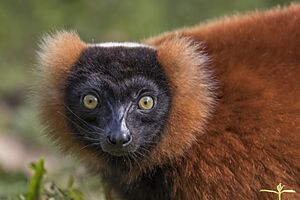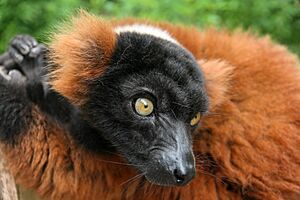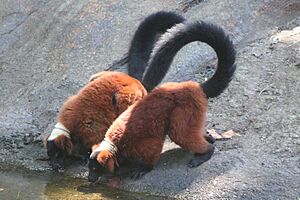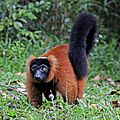Red ruffed lemur facts for kids
Quick facts for kids Red ruffed lemur |
|
|---|---|
 |
|
| Conservation status | |
| Scientific classification | |
 |
|
| Distribution of V. rubra | |
| Synonyms | |
|
The red ruffed lemur (Varecia rubra) is a special type of lemur. It is one of two kinds of ruffed lemurs, the other being the black-and-white ruffed lemur. Like all lemurs, it lives only on the island of Madagascar. You can find it in the rainforests of Masoala, which is in the northeast part of the island.
This lemur is one of the biggest primates in Madagascar. Its body is about 53 cm (21 inches) long, and its tail is even longer, around 60 cm (24 inches). It weighs about 3.3 to 3.6 kg (7 to 8 pounds). Its fur is soft and thick, mostly red and black. It often has a cream or buff-colored spot on the back of its neck. Some red ruffed lemurs might also have white or pink patches on their legs or feet, or a ring of similar color at the base of their tail.
Contents
Physical Characteristics of Red Ruffed Lemurs
Ruffed lemurs are the largest members of their lemur family. The red ruffed lemur is the bigger of the two ruffed lemur species. They usually weigh between 3.3 and 3.6 kg (7 to 8 pounds). Their bodies are about 53 cm (21 inches) long, and their tails are around 60 cm (24 inches) long. Female lemurs are usually a little bit bigger than males.
These lemurs have slim bodies and long legs. Their snout is narrow, and their small ears can sometimes be hidden by their long fur. They use special teeth, called a toothcomb, to keep their fur clean.
As their name suggests, they have a rust-colored ruff (a collar of fur) and body. Their heads, stomachs, tails, feet, and the inside of their legs are black. They have a white patch on the back of their neck. Some may also have white markings on their feet or around their mouth.
Red Ruffed Lemur Behavior
Red ruffed lemurs are very clean animals. They spend a lot of time grooming themselves and each other. This is called social grooming. They have special lower front teeth and a claw on their second toe that help them groom. Their lower front teeth grow forward, forming a "toothcomb" to comb their soft fur. The claw is also used for grooming.
In the wild, red ruffed lemurs usually live for 15 to 20 years. In zoos, they can live longer, sometimes up to 25 years. One even lived to be about 33 years old! These lemurs are diurnal, meaning they are active during the day. They are most active in the morning and evening.
Social Life and Group Behavior
Red ruffed lemurs typically live in small groups. These groups usually have 2 to 16 individuals. Sometimes, much larger groups of up to 32 lemurs have been seen. The female lemurs are usually in charge of the group, which is called a matriarchal system.
Their main food is fruit, nectar, and pollen. If fruit is hard to find, they will also eat leaves and seeds. During the wet season, when there is plenty of food, red ruffed lemurs might form large groups. They will all find one food source and eat together. However, in the dry season, when food is scarce, they often split up to find food on their own. This is different from most other lemurs, who usually stay in large groups even when food is scarce.
Studies show that red ruffed lemurs might live in pairs or in small, organized groups. They communicate with each other using loud, booming calls. These calls can be heard from far away in the forest.
Reproduction and Life Cycle
Red ruffed lemurs can start having babies when they are about three years old. Unlike most other primates that are active during the day, female red ruffed lemurs build nests for their babies. These nests are usually 10 to 20 meters (33 to 66 feet) high in the trees. They make the nests from twigs, leaves, vines, and even some of their own fur.
Like all lemurs, they have a specific time of year for breeding, which is from May to July. This is so the babies can be born during the wet season when there is more food available. Red ruffed lemurs are also the only primates that have litters of young. After about 102 days of gestation (pregnancy), a female can give birth to up to six babies. However, two or three babies are more common.
Newborn lemurs have fur and can see, but they cannot move much. The mother keeps them in the nest until they are about seven weeks old. A mother can nurse up to six babies at the same time. Red ruffed lemur babies are not as developed at birth as other lemur babies. This is because their pregnancy period is very short.
When a mother needs to move her babies, she picks them up one by one. After a week or two, mothers usually move their babies out of the nest. When the mother goes to find food, she leaves her babies in a nearby tree. For the first few days after birth, if the mother leaves the nest, the father will often stay to guard the babies. Babies stop drinking milk from their mother at about four months old. Sadly, about 65% of young lemurs do not live to be three months old. They often die from falling out of trees.
What Red Ruffed Lemurs Eat
The red ruffed lemur mostly eats fruit. This makes them frugivores. They are especially fond of figs. They also eat leaves and young shoots when fruit is not as available.
How Red Ruffed Lemurs Communicate
Scientists have recorded about twelve different calls that red ruffed lemurs make. Interestingly, red ruffed lemurs and Black-and-White Ruffed Lemurs can understand each other's calls, even though they live in different parts of Madagascar. They also use scent marking to communicate, leaving their smell on things to send messages to other lemurs.
Conservation Status of Red Ruffed Lemurs
The IUCN Red List says that the red ruffed lemur is critically endangered. This means they are at a very high risk of disappearing from the wild. Many things threaten them, including:
- Logging (cutting down trees)
- Burning of their habitat (the place where they live)
- Strong storms called cyclones
- Mining
- Hunting
- The illegal pet trade (people taking them from the wild to sell as pets)
They also have natural predators like large snakes, eagles, and the fossa, which is a cat-like animal from Madagascar.
In 1997, the Masoala National Park was created. This park helps protect the red ruffed lemurs that live inside its borders. However, many red ruffed lemurs live outside the park and are still in great danger.
Recent studies show that their wild population is shrinking. Illegal logging has increased since 2009, which has destroyed much of their forest home. Cutting down valuable trees like rosewood illegally is a big problem, and it's linked to political problems in Madagascar.
There are about 590 red ruffed lemurs living in zoos around the world. These captive populations are managed by a plan called the Species Survival Plan. Many zoos work together to breed and care for these lemurs. To keep the captive lemurs healthy and genetically diverse, some wild-caught lemurs have been added to the breeding programs.
Images for kids








